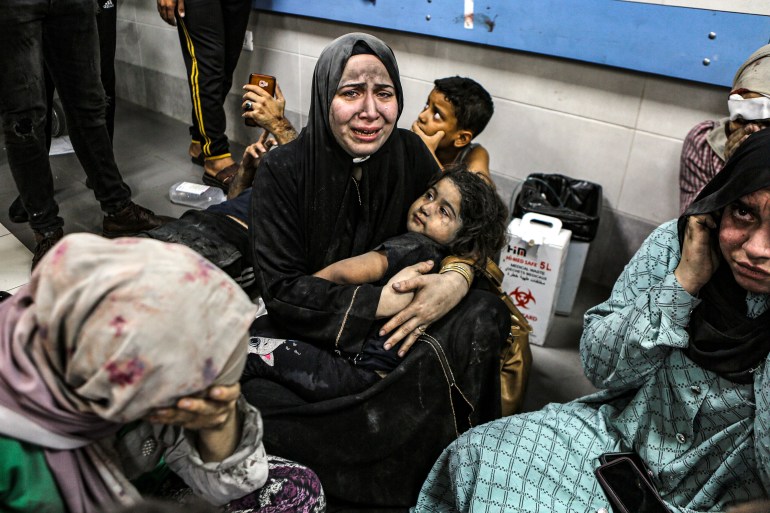Ten days into Israel’s brutal war on Gaza, a few seconds of footage showing a projectile exploding in the night sky became the centre of a furious debate.
Israel claimed that the clip, captured by an Al Jazeera livestream at 18:59:50 on October 17, showed that a misfired Palestinian rocket was responsible for the deadly blast at al-Ahli Arab Hospital that occurred five seconds later.
Investigations by Al Jazeera and the New York Times showed that the projectile in question had nothing to do with the hospital tragedy. But, by then, the theory that the blast had been caused by a Palestinian rocket had taken on a life of its own, endorsed by open source intelligence (OSINT) researchers and commentators lured by groupthink and confirmation bias.
This matters. Before the conflict, OSINT journalism was already well established, bringing new rigour to reporting of events in places like Cameroon, Syria, Ukraine and Yemen. Organisations like Bellingcat and Forensic Architecture won plaudits for restoring the primacy of fact over opinion, helping to expose war crimes.
In Gaza, the trend has peaked. International media, locked out of the conflict zone, have been increasingly dependent on open source materials, including footage from Al Jazeera, the only global media organisation with a consistent presence in Gaza throughout the war.
There have been notable OSINT breakthroughs – including by Al Jazeera’s fact-checking unit Sanad, which disproved Israel’s claim of a Hamas tunnel under al-Shifa Hospital, and showed how Palestinians fleeing northern Gaza on Israel’s instructions were killed while on the very “safe routes” that Israeli forces had told them to take.
But, as the al-Ahli hospital episode illustrates, the war has also presented new challenges for the rapidly expanding field. To understand how OSINT practitioners have stumbled in this war, Al Jazeera spoke to Idrees Ahmad, associate editor at New Lines Magazine and director of journalism at the University of Essex.

Al Jazeera: You’ve written about how open source research has reinvigorated war reporting. It seems to have occupied an especially important place in Gaza, with open source pundits attracting huge mainstream attention online. Your thoughts?
Idrees Ahmad: The OSINT landscape has changed quite a bit over the years. In the case of Syria, the OSINT community was doing very rigorous work, associated with unlocking war crimes investigations. But in Gaza, something opposite is happening. We’ve seen anonymous accounts posting speculative information, giving it the form and aesthetics of OSINT, but without the rigour. This information spreads fast, becoming a kind of groupthink, which makes it very difficult for anybody to swim against.
Al Jazeera: Let’s unpack what happened with al-Ahli. Why is it noteworthy?
Ahmad: Al-Ahli was significant. The important thing was that it happened in the context of many similar attacks on hospitals. The justification was that the hospitals were either being used to launch attacks or being used as headquarters by Hamas. Interestingly, the immediate assumption among media was that Israel did it.
Al Jazeera: Yes. Can you describe how the tide then turned?
Ahmad: It started with a couple of anonymous OSINT accounts, which had the appearance of precision and rigour associated with OSINT. So one analysed the Al Jazeera livestream of the projectile exploding midair, suggesting that the coordinates of that rocket were right over the hospital, which clearly supported the theory that a Palestinian rocket had exploded in the air and then caused the explosion on the ground. Another took separate footage, reaching the same conclusion.
Al Jazeera: Wasn’t there also lots of focus on the OSINT visuals of the hospital car park, with the crater that appeared too small for an air strike?
Ahmad: Yes, after the initial anonymous accounts put out their theory, suddenly everyone started jumping in to speculate that Israel’s version of events was correct. It triggered a kind of groupthink where everyone was engaging in speculation and deductive logic to substantiate that theory without any physical proof.
Al Jazeera: Can you be more specific? How did the groupthink develop?
Ahmad: Yes, obviously none of us witnessed the strike directly. But we do know that the perceived rigour of the OSINT people became the basis for a theory based on error.
One of the things that happens when so-called experts get quoted is that their reputation gets tied to a theory, which is then endorsed by other experts. So it got to the point where a respected figure in the OSINT community shared this Wall Street Journal video which claimed to have multiple angles on the rocket and very conclusively said that it caused the explosion. And as the NYT investigation proved, this was certainly not the case.

Al Jazeera: Yes, this was major, right? The NYT was saying the ‘rocket’ wasn’t Palestinian at all. It was an object launched from near an Iron Dome centre in Israel that exploded a couple of miles away from al-Ahli. Surely a reason for returning to the drawing board?
Ahmad: The thing is, once the New York Times came out and debunked the Israeli assertion that the projectile in the Al Jazeera video had caused the explosion, people started looking for new rationalisations to hold onto their conclusion. That’s the essence of conspiracy theory.
Al Jazeera: So what’s the upshot of all this?
Ahmad: It raises serious questions about these very confident judgements. There was no rush to admit that they got it so royally wrong. Or to maybe suspend judgement until there was an investigation or something. AP, for example, had published its own open source investigation, basically regurgitating the extant theories, using the same group of eager experts. Once the story collapsed, it simply turned to a new group of experts – smaller and more obscure – willing to endorse the ‘failed rocket’ thesis.
The thing is, it’s successfully created a fog of disinformation. It’s obvious that Israel was attacking hospitals at the time. But, instead, we now have this big question mark over this one event. So, if there’s doubt around this one, it somehow makes every other incident questionable.

Al Jazeera: So al-Ahli became a sort of barometer of which side should be believed? Do you think the pendulum simply swung the other way?
Ahmad: Yes, and even the NYT went further than they needed to. I mean, their investigation was solid. But even they felt obliged to pay lip service to the failed rocket theory. They didn’t need to engage in speculation. Perhaps because they were debunking it, they felt they needed to make some sort of concession to that theory. So they were still saying a Palestinian rocket might have been responsible, alluding to footage of a barrage of Palestinian rockets being fired in the area, pointing out that the aftermath did not look like an Israeli air strike and that Hamas had not produced evidence.
Al Jazeera: So we’ve got this one element of clarity, that the projectile in the video had nothing to do with the explosion and then we’ve got all this noise? But what about the Gaza health ministry’s claims of 500 deaths, which were later revised? Do you think that this fuelled attempts to discredit Palestinian claims?
Ahmad: Yes there was a revision, but it was still a pretty significant number. The interesting thing about that was that this [Israeli] narrative [about Palestinian claims on deaths] was itself then contradicted by a senior US official, who said that the estimates of the overall death toll may actually be higher than what the Gaza health ministry reported.
Al Jazeera: So will we ever find the truth about al-Ahli?
Ahmad: It’s always been the key Israeli strategy, to create a fog. I mean, there are people who still insist that Israel never killed Muhammad al-Durrah. Twenty years on, they still say that the video of the child being shielded by his father was staged or that he was killed by Palestinian gunfire. In time, physical [evidence] often perishes and memories degrade, so nobody can then confirm or deny what happened. And you know, the same thing happened here. Even if somebody gets tasked with investigating in the future, where are they going to find reliable evidence?

Al Jazeera: What’s the main takeaway from all this?
Ahmad: I understand why Israel would obfuscate; or why the anonymous accounts of dubious provenance might plant misinformation. My concern is with the groupthink infecting the OSINT community where instead of challenging erroneous beliefs, some found creative ways to sustain prevailing orthodoxies. There is a particular need in the OSINT community to guard against infiltration by state actors.
The aim of propaganda is to get people to act in accordance with the propagandist’s wishes. Sometimes the aim is merely to obfuscate to ease your audience’s cognitive dissonance. Israel didn’t need to prove anything because, like any side in a conflict, they have an eager audience, predisposed to believe whatever they give them. So they’re just giving the audience something to counter claims of mass atrocity.
It’s not a tactic exclusive to Israelis. A few years back, Seymour Hersh wrote an article in Die Welt, countering charges that the Syrian government had attacked Khan Sheikhoun with sarin. Just as Israelis used a fake audio intercept supposedly confirming Palestinian responsibility for the attack, Hersh’s story about Syria also featured the transcript of a supposed conversation between rebels planning the attack. Both were debunked and became fodder for satire. But the thing is, supporters of both Israel and the Syrian regime lapped it up.
Al Jazeera: So we believe what we want to believe?
Ahmad: If you’re ideologically predisposed to believing something, your threshold of scepticism becomes very low. You just accept.
Read More: World News | Entertainment News | Celeb News
Aljazera







